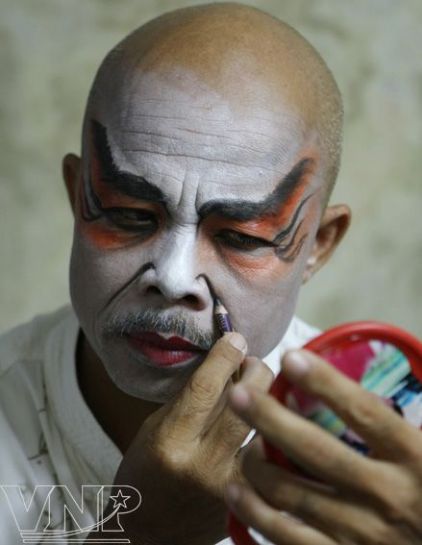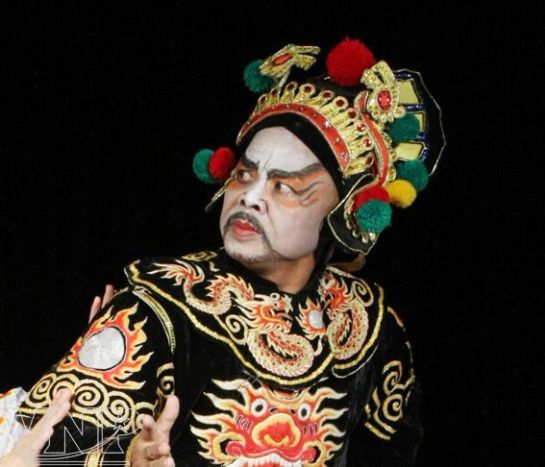|
Applying
the face make-up for Tuong
(classical drama) performers is really an art itself, describing the
personality of the characters in the drama. Watching the actors and
actresses on the stage in their Tuong costumes, particularly their specific face
make-up, the audience can guess what roles they will perform.
The colours
for face make-up are mostly white, red, green and black, each used for one
specific character. For example, a white face represents a calm and
handsome man; a red face for the intelligent and courageous; a striped
face for the ugly and hot-tempered; a black-striped face with a red line
on his temples for the treacherous and hot-tempered, or with black stripes
on a red or green base for the strong and brave; a mould-gray face for the
smooth talkers and a ploughshare-shaped face for the unfaithful and
poor-spirited.
|

The eyes of a cunning and crafty district
chief.
|
|

Actress Kieu Oanh with her
carefully applied face make-up when acting a
double role in the
play “Old Husband Carries his Young Wife to the Festival”.
|
|

Deepening two lines near the nose
is often done for
make-up of the King’s face.
|
|

In the make-up room of the
Tuong artists at Hong Ha Theatre in Hanoi.
|
|

Merited Artist Han Van Tinh in
the play “Phung Nghi Dinh”.
|
|

Actors and actresses in the play
“Phung Nghi Dinh”, each having distinguishing face
make-up.
|
|

Actress Kieu Oanh in the play “Old
Husband Carries his Young Wife to the Festival”.
|
|

On the stage, the roles
performed by the artists are highlighted
partly due to the
unique face make-up.
|
However
the two most remarkable types of face make-up are white and striped faces,
which express the beauty of actions, not appearance, in Tuong
performance. The white face represents both the loyal and disloyal
characters, such as Dich Thanh and Hua Hon Van (loyal), and La Bo and Ly
Thong (disloyal), and the same as the striped face for the loyal (Luu
Khanh and Truong Phi) and disloyal (Ta On Dinh, Xich Bao)
characters.
So,
face make-up represents the beauty of the national aesthetics. The artist
uses colours to draw his face, except the area around his eyes, because
the soul and mood of the character is always reflected through the
performer’s eyes. Researchers in Tuong art said this practice originates from the
wearing of masks in the old days.
Tuong
artists do their own make-up, hence to some extent they are painters and
their personal characteristics influence their face make-up. Tuong is
considered as an art having a highly symbolic and conventional value that
is fully expressed through face make-up.
Merited
Artist Bich Tan from the Central Tuong Theatre who often acts the role of Ho Nguyet
Co in the play “A Fox Incarnated into Ho Nguyet Co” said: “When doing face
make-up, I pay much attention to my eyes. Ho Nguyet Co is a fox, and with
a miracle from a gem it becomes a beautiful girl. Her eyes express her
mood. Normally the eyes are so keen, but they become so passionate and
full of love when she fells in love with Tiet Giao.”
Actress
Kieu Oanh who plays the roles of the wife and husband in the play “Old
Husband Carries His Young Wife to the Festival”, said: “Performing these
roles is very difficult because of the way the actress must walk and
perform the facial expressions. So the face make-up requires great
attention to detail during application.”
In
such classic roles as Guangong
or the generals, face make-up requires sophisticated work, particularly
for the eyes and the eyebrows. Merited Artist Han Van Tinh who performs
the role of the king in the play “Phung Nghi Dinh” said: “It takes me two
hours to do the face make-up for the roles of the king and lords. The Tuong artist has to do the job of a painter when
drawing his face with lines or changing his face’s colour complexion to
darker or brighter one”.
It
is quite difficult to train a Tuong performer and much more difficult to train
those who can do the face make-up for themselves. Such ability of the
artists is very important because it helps to enhance the performance and
enthral the audience.
|
Tuong
plays are performed twice a week, on Wednesday and Thursday, at
5pm., at Hong Ha Theatre, No.51
Duong Thanh Street – Hanoi.
Ticket fee: 50,000
VND/person
|
Story: Bich
Van
Photos: An Thanh Dat
– Phuong Hoa
|











